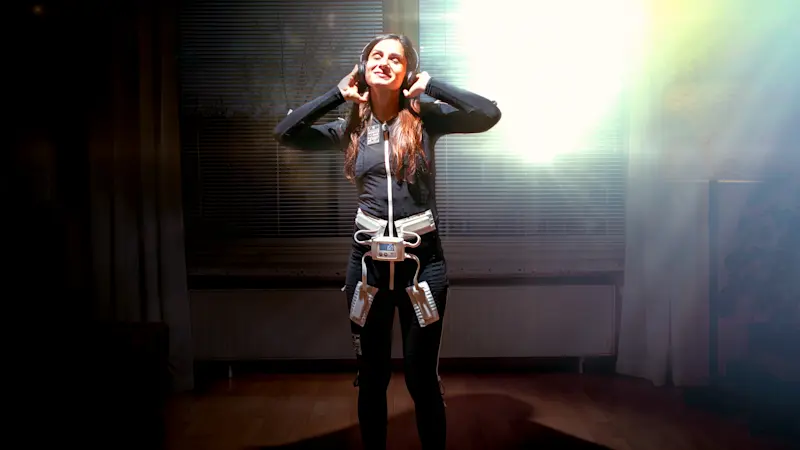Unlocking patient’s potential
Experts share study results about innovations in neurological care with C-Brace and Exopulse Mollii Suit

Friday, 5 July 2024
The online symposium “Unlocking patient’s potential: Innovations in Neurological Care with C-Brace and Exopulse Mollii Suit” was held on 25th June 2024 in Duderstadt (Germany).
It explored recent advancements in neurological care, focusing on two topics: Recent research on the Microprocessor Controlled Stance and Swing Orthoses (MC SSO) C-Brace showed effectiveness in improving gait and function for community ambulators experiencing knee locking deficiency. The current evidence on Exopulse Mollii Suit and its effects on patients with fibromyalgia, multiple sclerosis and stroke was elucidated.
Moderated by Dipl.-Ing. Merkur Alimusaj, the Head of Technical Orthopaedics at the Department for Orthopaedics, Trauma Surgery, and Paraplegia in Heidelberg, Germany, the symposium featured several esteemed international speakers. Among them were Aurélie Lacroix, Dipl.-Ing., CPO, who serves as a Clinical Studies Manager at Ottobock France in Nancy, France; Prof. Dr. Samar S. Ayache, MD, PhD, HDR, an Associate Professor of Clinical Neurophysiology at the Faculty of Medicine, Paris-Est University in Creteil, France, as well as an Adjunct Professor of Neurology at the Lebanese American University School of Medicine in Beirut, Lebanon, and a Neurologist and Neurophysiologist at Henri Mondor Hospital in Creteil, France. The final speaker was Prof. Naji Riachi, MD, the Medical Director of the Burjeel Neurosciences Center and Director of Epilepsy Services at the same center in Abu Dhabi, United Arab Emirates (UAE), as well as a Professor of Neurology at Khalifa University in Abu Dhabi, UAE. The symposium provided a platform for these experts to share their insights and advancements in their respective fields, contributing to a rich exchange of knowledge and innovative ideas.
Aurélie Lacroix presented C-Brace’s impact on mobility and quality of life in community ambulators
Aurélie Lacroix presented the results of an international randomized cross-over trial that assessed mobility and quality of life with C-BRACE compared to Stance Controlled Orthoses (SCO).
Lacroix highlighted that while active patients often use SCOs for an almost physiological gait on level ground, these orthoses face significant limitations outdoors or in more challenging environments. This observation led to a study focusing on community ambulators—individuals capable of walking at least 3 km/h. Conducted by 17 rehabilitation centers in France and Germany, the study involved 38 community ambulators who tested both SCO and C-Brace in random order. After a two-month follow-up period, patients evaluated the impact of each orthosis.
Results demonstrated significant improvements in all aspects of mobility of the patients with the C-Brace, including self-perceived mobility (PLUS-M), endurance (6 Minute Walk Test), balance confidence (ABC-s), and participation (Patient Specific Functional Scale). “It was also very interesting to see that in outdoor situation, the use of walking aids was significantly less frequent with C-Brace than with the SCO,” said Lacroix.
Furthemore, she shared the remarkable impact of C-Brace on quality of life (EQ-5D-5L), with the average utility score rising from 0.692 with SCO to 0.88 with C-Brace. At the end of the study, 86.7 % of patients expressed a preference for C-Brace, reflecting its positive impact on mobility and quality of life. However, as concluded byLacroix “fitting C-Brace requires a custom-made device, new functionalities, and a new gait pattern, necessitating the expertise of a multidisciplinary team to ensure successful integration and life-changing benefits”.
Prof. Samar Ayache presented the results of the EXOFIB-1 study – effects of Exopulse Mollii Suit on fibromyalgia-related symptoms
During the symposium, Prof. Ayache highlighted the prevalence of fibromyalgia in the USA and worldwide, the complexity of its pathophysiology, and the challenges physicians face when it comes to relieving patients with this disease.
Pharmacological and alternative therapies for fibromyalgia management fail to meet patients' expectations in a large proportion of cases. Thus, noninvasive stimulation methods appear highly pertinent in this domain, but their place is yet to be determined. Therefore, EXOFIB – 1 study took place at Henri Mondor Hospital, France. The aim was to assess the effects of a multisite transcutaneous electrical nerve stimulation device, known as the Exopulse Mollii Suit, on pain, fatigue, emotional symptoms, and quality of life in patients suffering from this condition.
Prof. Ayache presented the study design and explained that the trial included two phases: a randomized phase (phase 1 with a cross-over sham-controlled double-blind design), followed by an open-label phase (phase 2). Study outcomes included the Visual Analogue Scale (VAS) for pain (primary outcome) and other questionnaires for pain (Brief Pain Inventory (BPI) and Pain Catastrophizing Scale (PCS)), fatigue (VAS fatigue), mood (Hospital Anxiety and Depression scale), quality of life (SF 36) and disease impact (Fibromyalgia Impact Questionnaire).
Thirty-three patients (93.9 % females), with a mean age of 51.3 years, finished the trial. Following active intervention, compared to sham condition, pain (the primary endpoint) was considerably reduced according to VAS (p=0.014) and to a subscale of BPI, but not to PCS. Apart from depression, many of the secondary endpoints (fatigue, anxiety, disease impact, and some aspects of quality of life) also showed significant changes. In Phase 2, most outcomes have significantly improved (including depression and almost all aspects of quality of life). In phases 1 and 2, patients reported a clinical impression of improvement in 63.6 % and 78.8 % of cases, respectively.
Prof. Ayache explained that “The study showed promising results in a difficult-to-treat condition, especially in patients with poor response to the available pharmacological and non-pharmacological management” and that “the nociceptive effect could be obtained after two weeks of active treatment, however, modulation of the affective and cognitive components of pain seem to require a more prolonged stimulation protocol.” She suggested “some potential underlying mechanisms”, including the gate control theory and the modulation of the central sensitization phenomenon.
Prof. Naji Riachi presented promising research on non-invasive neurostimulation for spasticity in patients with multiple sclerosis and stroke
Prof. Naji Riachi highlighted ongoing research at two centers in France and Abu Dhabi, presenting data from the EXOSEP and EXOSTROKE studies. These involve patients with multiple sclerosis or stroke who suffer from spasticity, a common and debilitating condition that impairs gait, balance, mobility, and quality of life. Current treatments leave significant unmet needs, underscoring the potential of non-invasive neurostimulation using the Exopulse Mollii Suit.
The studies are conducted in two phases: an initial cross-over, randomized, placebo-controlled, double-blind trial, followed by an open-label phase. Preliminary data from the multiple sclerosis study showed improvements in the Berg Balance Scale, the primary endpoint of the studies. Videos illustrated enhanced patients’ balance and pendulum, with an increased step length and velocity, smoother movements, and less need for walking aids.
Similarly, the stroke study's preliminary analysis revealed improvements in the Berg Balance Scale with videos. They demonstrated improvement in the speed, with increased velocity step length, and improved hip flexion. “Despite the short stimulation periods, some positive results were also noted in the upper limb, that would call for studies with longer stimulation periods,” said Prof. Riachi. As explained further, “the mechanism of action of the Mollii suit is thought to be the reciprocal inhibition reflex. Modulation of this mechanism, which stimulates antagonist of the spastic muscle, will lead to activation of the inhibitory neurons in the spinal loop, leading to reduction of the excitability of the motor neurons in the spastic muscle, and hence, its relaxation.”
The mentioned studies will soon conclude, with analysis extending to secondary endpoints such as pain, fatigue, mobility, spasticity, and quality of life.
Symposium wrap-up
The symposium was characterized by active panel discussions from the audience and speakers. Concluding the symposium, Dipl.-Ing. Merkur Alimusaj emphasized the transformative impact of innovative neurostimulation technologies on patient mobility and quality of life, advocating for further research and multidisciplinary collaboration to optimize these life-changing treatments.
The results of an international randomized cross-over trial demonstrated significant improvements in mobility and quality of life for community ambulators using C-Brace compared to SCO. Benefits of C-Brace in outdoor and challenging environments were highlighted, with patients reporting enhanced mobility, endurance, balance confidence, and overall quality of life.
Furthermore, the EXOFIB-1 study highlighted the potential of the Exopulse Mollii Suit in managing fibromyalgia-related symptoms. Promising results showed significant reductions in pain and improvements in fatigue, anxiety, disease impact, and quality of life, offering new hope for patients with this condition.
Additionally, preliminary data from ongoing research at centers in France and Abu Dhabi on patients with multiple sclerosis and stroke – the EXOSEP and EXOSTROKE studies. They revealed notable improvements in balance and mobility, highlighting the potential of the Exopulse Mollii Suitin addressing the unmet needs in this patient population.
To view the recording of the symposium, please register by clicking on this link: Unlocking patient’s potential (ottobock.com)
After successful registration, the link to the recording will be sent in the confirmation email.

